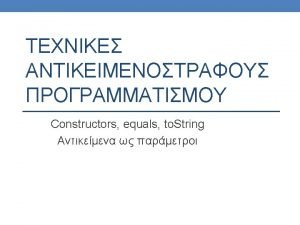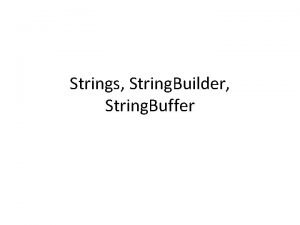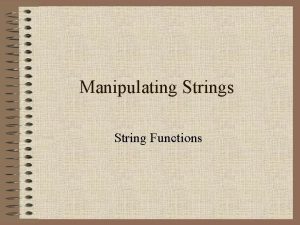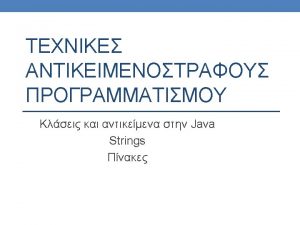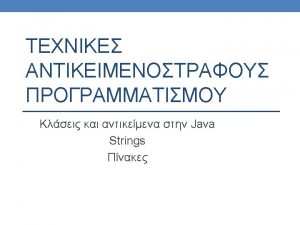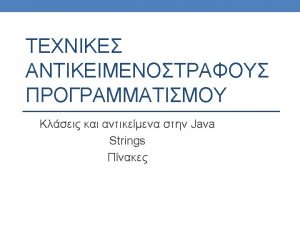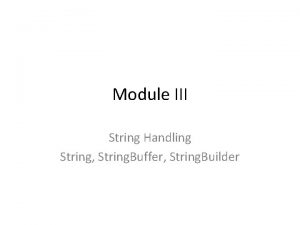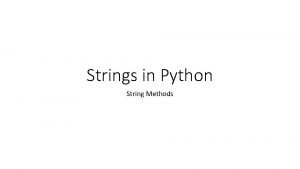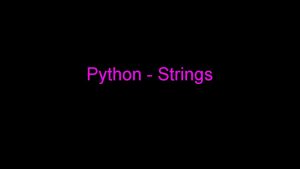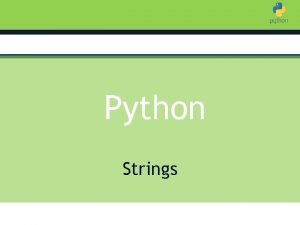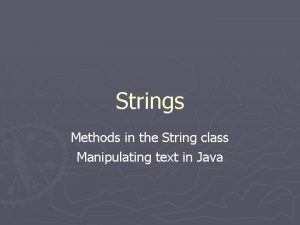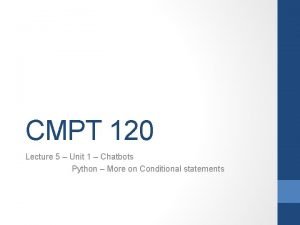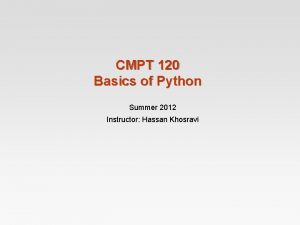CMPT 120 Topic Python strings Manipulating Strings String




















- Slides: 20

CMPT 120 Topic: Python strings

Manipulating Strings • String (sequence) manipulation operators: • Syntax: <operand> <operator> <operand> • Operators: • Concatenation operator: + • Both operands must be of str data type • Repetition operator: * • One operand must be of str data type • The other operand must be of int data type • Format operator: % • String formatting • Examples: >>> dessert. Today = "ice" + "cream" >>> guffaw = "ha" * 3 # OR 3 * "ha" >>> age = 26 >>> message = "Paul is %i years of age. " %age >>> print(message) Paul is 26 years of age. 2

String indexing: positive indexing How to access one string character at a time? Answer: Use the index associated with the character as illustrated below: positive indexing-> index: 0 1 2 3 4 5 6 7 8 9 10 11 12 Example: message = "Hello, World!" • So if we wish to access • The 1 st character of the string, we use the index 0 • The 2 nd character of the string, we use the index 1 • etc… 3

String indexing: positive indexing examples When does the “Index. Error: string index out of range” error occur? 4 Careful: Positive index starts at 0

String indexing: negative indexing • There is another way we can use to access one string character at a time: negative indexing: Example: message = "Hello, World!" negative indexing-> index: -13 -12 -11 -10 -9 -8 -7 -6 -5 -4 -3 -2 -1 • So if we wish to access • The 1 st character of the string, we use the index -13 • The last character of the string, we use the index -1, • etc… 5

String indexing: negative indexing examples When does the “Index. Error: string index out of range” error occur? Careful: Negative index starts at -1, not 0 6

String slicing (using positive indices) How to access a section (slice) of a string at a time? Answer: use indices to indicate the string slice positive indexing-> index: 0 1 2 3 4 5 6 7 8 9 10 11 12 Example: message = "Hello, World!“ Syntax: <a. String>[start : stop : step] • start • stop • step • Example: So if we wish to access the string slice "Hello", we use message[0: 5] 7

How does String Slicing works? positive indexing-> index: 0 1 2 3 4 5 6 7 8 9 10 11 12 Example: message = "Hello, World!“ • message[0: 5] • We use index 0 to indicate the start of the string slice • Inclusive -> the character at index 0 is included in the string slice • We use index 5 to indicate the stop of the string slice • Non-inclusive -> the character at index 5 is ***not*** included in the string slice 8

String slicing - Examples Note what happens when stop represents an index that is out of range, i. e. , the index 25 no longer correspond to a character of the string message since this string only has 13 characters, i. e. , from index 0 to index 12. So, Python interprets the index 25 to mean “all the way to the end of the string”. Therefore, it creates a slice of the string message from its character at index 7 all the way to its last character (because the index of this last character is < 25). 9

String slicing (using negative indices) Example: message = "Hello, World!" negative indexing-> index: -13 -12 -11 -10 -9 -8 -7 -6 -5 -4 -3 -2 -1 10

Strings are immutable! • Definition of Immutable: • Can we modify a string? • For example, let’s try: message[12] = "? " • Here is what happened when we tried? 11 • Why?

Strings are immutable! • But we can create another string that is a modified version of the first string • Let’s try this Python program: message = "Hello, World!" question = message[: 12] + "? " print("message is still: ", message) print("question is: ", question) • What is the output of the above program? 12

Summary: Strings (sequence) manipulation Operation Name Operator/ function Comment concatenation + Combine strings together repetition * Concatenate a string that is being repeated a number of times indexing [n] Access an element of a string slicing [: : ] Extract a part of a string length len(a. String) Determine the number of characters in a string a. String 13

Built-in functions for strings • len( ) is an example of a built-in function for strings in Python • Let’s try it on message • Notice that the valid range of the indices for the string message is 0 to 12 • So … • If the length of a string is x then we know that the valid range of the indices for that string is 0 to x-1 • If the valid range of the indices for a string is 0 to y then we know that the length of that string is y+1 14

Other useful built-in functions Method name Use Comment maximum max(a. String) within a string Returns the maximum value among the characters in the string a. String minimum min(a. String) within a string Returns the minimum value among the characters in the string a. String We can find more built-in functions at: https: //docs. python. org/3. 5/library/functions. html 15

Methods • Aside from built-in functions, Python also has methods, which are a specific type of functions that are related to classes • Class is a mechanism that allows us to create our own type of objects (variables) • Syntax for methods: <string>. <method>(<arguments>) dot notation Arguments are not always needed. How do we know if they are? Answer: We must look at a description of the method. 16

Methods for strings • Methods are called using the dot notation, and are applied to a string that already exist • Let’s try this Python program: greetings = "Hello" new. Greetings = greetings. upper( ) print(new. Greetings) print(greetings) The result is: 17

Some string methods Method name Use Comment center a. String. center(w) Returns a new string, with [the contents of] a. String centered in a field of size w count a. String. count(item) Returns the number of occurrences of item in a. String ljust a. String. ljust(w) Returns a new string, with a. String left justified in a field of size w rjust a. String. rjust(w) Returns a new string, with a. String contents right justified in a field of size w upper a. String. upper() Returns a new string, with a. String contents all in upper cases lower a. String. lower() Returns a new string, with a. String contents all in lower cases find a. String. find(item) Returns the index of the first occurrence of item in a. String 18

A few more string methods • • • title( ) strip( ) rfind( ) isdigit( ) isalpha( ) isnumeric( ) islower( ) isupper( ) isspace( ) capitalize( ) etc. 19

More information about string methods • You can find a lot more string methods at: https: //docs. python. org/3. 5/library/stdtypes. html#index-31 • Even though we may not talk about all the Python string methods during our lectures, our task, as a Python software developer (i. e. , CMPT 120 students), is to become familiar with Python string methods as they will be very useful to us in solving our problems/tasks throughout the semester 20
 Http protocol description
Http protocol description Cmpt 120
Cmpt 120 Cmpt120
Cmpt120 Cmpt 120
Cmpt 120 What is a function header in python
What is a function header in python Python compare strings
Python compare strings 120px x 120px
120px x 120px 160+140
160+140![Const int size=18; string *tbl2 = new string[size]; Const int size=18; string *tbl2 = new string[size];](data:image/svg+xml,%3Csvg%20xmlns=%22http://www.w3.org/2000/svg%22%20viewBox=%220%200%20200%20200%22%3E%3C/svg%3E) Const int size=18; string *tbl2 = new string[size];
Const int size=18; string *tbl2 = new string[size]; Public class person private name
Public class person private name String str
String str Python string builder
Python string builder Manipulasi string python
Manipulasi string python String format python
String format python Python difference list tuple
Python difference list tuple Pythoniseasy.com
Pythoniseasy.com String art python
String art python Clincher examples
Clincher examples Narrow topic examples
Narrow topic examples Section break slide
Section break slide Process of manipulating images and sounds
Process of manipulating images and sounds





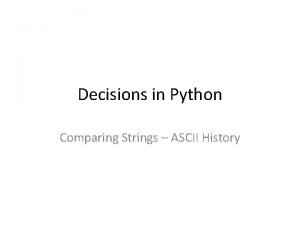


![Const int size=18; string *tbl2 = new string[size]; Const int size=18; string *tbl2 = new string[size];](https://slidetodoc.com/wp-content/uploads/2020/11/1588947_40cf3415d0afabae1c436a49b39f4ad0-300x225.jpg)
